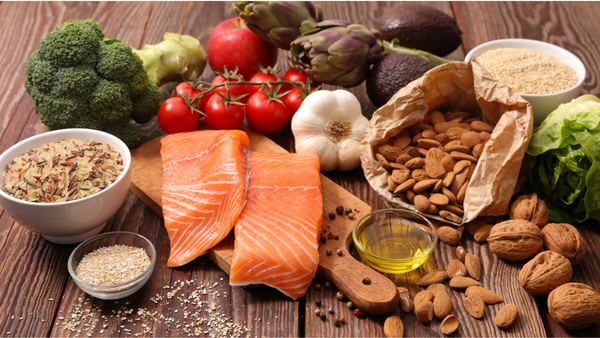Iodine is an essential trace element that we must consume through our diet.
Iodized table salt was introduced in Germany to counteract iodine deficiency. Unfortunately, iodine deficiency is still widespread. Most people are not aware of this.
Here you can find out which foods are rich in iodine and how you can meet your needs.
IT'S WORTH READING!
AT THE END OF THE ARTICLE WE WOULD LIKE TO GIVE YOU A LITTLE JOY WITH A VOUCHER!
Iodine requirement
According to the German Nutrition Society (DGE), the daily requirement of iodine is 180 – 200 µg. Pregnant and breastfeeding women have an increased requirement of 230 µg and 260 µg respectively. [1]
Since the soil in Germany is low in iodine, a deficiency is unfortunately widespread. According to the Federal Institute for Risk Assessment, 30% of adults and 44% of children do not consume enough iodine.
In our detailed article on iodine you will learn more about this underestimated trace element.
Here is a list of foods that contain iodine: [2]
1. Iodized table salt
With 5070 µg of iodine per 100g, iodized table salt contains by far the most iodine per gram. But of course we only consume a few grams of salt per day. Nevertheless, iodized table salt is an important source of iodine.
2. Algae
Seaweed comes right after iodized table salt when it comes to iodine. They are particularly rich in iodine in dried form, as all the nutrients are then concentrated. Dried nori seaweed, for example, provides 2320 µg of iodine per 100 g.
However, iodine can be problematic in excessive amounts, so you should be careful when consuming algae. Too much iodine can be dangerous, especially for Hashimoto's disease.
If you are not a big fan of seaweed, there are also nutritional supplements that contain kelp brown algae . This is a very easy way to meet your iodine needs.
By the way, algae salt (salt with added algae) is a great alternative to iodized table salt. There is no difference in taste.
3. Eggs
Eggs are also a good source of iodine: they contain 49.2 µg of iodine per 100 g. You may be wondering how the iodine gets into the eggs if the chickens eat feed that comes from iodine-poor soil. A very legitimate question! In fact, iodine is added to chicken feed to increase the iodine content in eggs. In addition to iodized table salt, this is another measure to counteract iodine deficiency.
By the way, eggs are a great food in general. They provide high-quality protein, healthy fats and almost all vitamins and minerals in generous amounts.

4. Milk
Milk and dairy products are also a good source of iodine. Milk contains 34.3 µg of iodine per 100 g. This is because iodine is added to animal feed. Milk and dairy products also provide high-quality protein, calcium and numerous B vitamins. For vegetarians, dairy products are an important source of vitamin B12 .
5. Sea fish
Sea fish is also rich in iodine. Salmon, for example, provides 26.2 µg of iodine per 100g. This is no surprise, because the iodine-rich algae are at the bottom of the food chain: fish either eat algae or smaller fish that have eaten algae.
In addition to iodine, fish is also rich in valuable omega-3 fatty acids and a good source of magnesium, selenium and B vitamins .
6. Seafood
Seafood also provides plenty of iodine. Shrimps, for example, contain 14.7 µg of iodine per 100 g. They also provide an extra portion of vitamin B12 and numerous minerals such as zinc, selenium , magnesium and copper . [3]

7. Meat
Meat contains moderate amounts of iodine, but significantly less than fish, eggs and dairy products. Turkey, for example, provides 2.1 µg of iodine per 100 g. Turkey is also rich in B vitamins and the minerals zinc and selenium. [4]
8. Legumes
Legumes also provide some iodine, but comparatively little. Kidney beans, for example, contain 1.1 µg of iodine per 100g. Legumes are also a good source of B vitamins (except vitamin B12), plant-based iron, manganese, magnesium and potassium . [5] For vegans, they are also an important source of protein.
9. Nuts
Nuts contain a similar amount of iodine to pulses. For example, almonds provide 1 µg of iodine per 100 g. Nuts therefore do not contribute significantly to meeting iodine requirements. However, nuts provide many other valuable nutrients, such as B vitamins (except vitamin B12), vitamin E, manganese, copper, magnesium , potassium and zinc.

10. Vegetables
Unfortunately, due to the iodine-poor soil in Germany, vegetables hardly provide any iodine. Carrots, for example, contain 0.5 µg of iodine per 100g. But vegetables are of course a very important source of vitamins and minerals, as well as secondary plant substances .
Conclusion: Iodine deficiency is widespread
Unfortunately, iodine deficiency is widespread in Germany due to soils that are poor in iodine. The best sources of iodine are iodized table salt, algae, fish and seafood, as well as eggs and dairy products. Since iodine is mainly found in animal foods, vegans should rely more on algae as a source of iodine or take iodine as a dietary supplement .
AS PROMISED, YOU WILL RECEIVE A 10% VOUCHER FOR OUR IODINE FROM ORGANIC Kelp .
SIMPLY COPY THE CODE JOD+V10 AND ENTER IT AT CHECKOUT.
Click here for product
[1] https://www.dge.de/forschung/referenzwerte/jod/?L=
[2] https://www.ars.usda.gov/northeast-area/beltsville-md-bhnrc/beltsville-human-nutrition-research-center/methods-and-application-of-food-composition-laboratory/mafcl -site-pages/iodine/
[3] Crustaceans, shrimp, mixed species, raw Nutrition Facts & Calories (self.com)
[4] Turkey, all classes, meat only, raw Nutrition Facts & Calories (self.com)
[5] Beans, kidney, all types, mature seeds, raw Nutrition Facts & Calories (self.com)

















